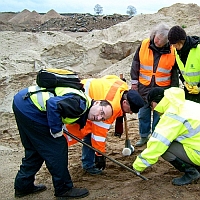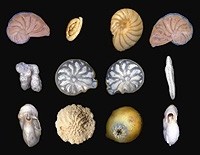



 Key to Species Articles
About
Key to Species Articles
About

 My name is Michael Hesemann, I live in Hamburg, Germany. I am interested in Earth Sciences and photography as a hobby. Foraminifera caught my interest at a micropaleontology course of the local Volkshochschule Hamburg in 2007. Dr. Uwe Marheinecke instructed and inspired me in microscopy, col- lecting sands, cracking rocks in order to find microfossils and recent specimens. My name is Michael Hesemann, I live in Hamburg, Germany. I am interested in Earth Sciences and photography as a hobby. Foraminifera caught my interest at a micropaleontology course of the local Volkshochschule Hamburg in 2007. Dr. Uwe Marheinecke instructed and inspired me in microscopy, col- lecting sands, cracking rocks in order to find microfossils and recent specimens.The image shows me in front looking back, exhausted after manual drilling, while analysis and explanation of the core is undertaken by our instructor Dr. Marheinecke. My collection of foraminifera grew and soon the question arose how to present the forams. I chose to make images rather then fix them in plummer-cells and started the webpage foraminifera.eu. Through the webpage and my postcard with the message on the back "send me your sample of sand or rock" I received several samples from amateurs and contributions by scientists. In 2008 I founded the Foraminifera.eu Project with Dieter Ketelsen and Karl-Otto Bock as the first team-members. They are long-time enthusiastic amateur naturalists in the field of macro- and micropaleontology, microscopy, preparation techniques, imaging and field-work. We frequently discussed all issues of the foraminifera.eu project and our local activities. In 2010 Stefan Raveling joined the inner circle providing valuable samples from |
drillcores and sharing his expertise on preparation techniques. In the course of time Brian Ottway and Prof. Dr. Michal Kucera became scientific advisors and Cai-Uso Wohler a team member with excellent skills in photgraphing. Karl-Otto - aged 90+ -left the team. To foster the community character we build teams, who work on single issues. As the collection has grown I added a database and query in order to more easily compare and sort images. The basic idea is to create plates as frequently seen in publications but let the user decide, which plate she/he gets. Technically to each image a set of data is attached reflecting standardized criteria on classification, locality, geological time, collection and habitat. The most simple techniques are used such as html, sql/php and excel.  In the course of time more than 120 contributors joined in and help to create the foraminifera.eu-project with at the moment 15.000+ illustrations online. It is astounding and highly motivating that no financial funding or institutional link is needed to run the project. Our mayor resource is naturalist enthusiasm and excitement about forams and what they tell us about life on Earth present and past. The foraminifera.eu project is non-commercial and wants to foster the awareness about earth-nature and one of its most abundant creatures. Aside of the project I started to write some papers. To the list of my publications. In the course of time more than 120 contributors joined in and help to create the foraminifera.eu-project with at the moment 15.000+ illustrations online. It is astounding and highly motivating that no financial funding or institutional link is needed to run the project. Our mayor resource is naturalist enthusiasm and excitement about forams and what they tell us about life on Earth present and past. The foraminifera.eu project is non-commercial and wants to foster the awareness about earth-nature and one of its most abundant creatures. Aside of the project I started to write some papers. To the list of my publications.Michael Hesemann, Hamburg 2020 |